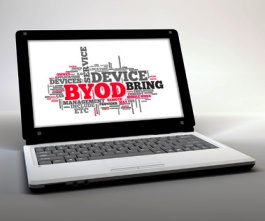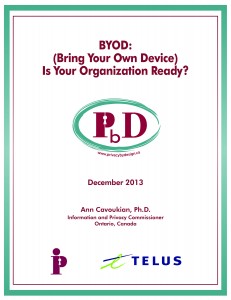More than 27 million Canadians use laptops, smartphones and tablets and that’s posing a big challenge in the workplace.

Canadian telecom provider TELUS has partnered with the Ontario Privacy Commissioner to produce a series of BYOD tips, recommendations and best practices; the company also has an online blog about bringing your own device to work.
Bring Your Own Device (BYOD) can mean convenience for users already very familiar and comfortable with their own mobile gadget, and efficiencies for the company that employs them.
But BYOD can present certain difficulties to company bosses, IT managers and employee privacy experts, and more.
Canadian companies are embracing BYOD faster than their global counterparts, but fewer than half (33 per cent) of Canadian organizations have a mobile device management policy in place.
That just opens the organization to additional security and privacy risks; in fact, more than half (58 per cent) of Canadian organizations lose sensitive corporate data each year through devices used by employees.
To help address the challenges and even mitigate the losses, Ontario’s Information and Privacy Commissioner, Dr. Ann Cavoukian, along with wireless service provider TELUS have released a new report called Bring Your Own Device: Is Your Organization Ready?
Every organization considering a BYOD strategy will need to look carefully at its own situation, and the needs of its employees, but the paper does set out some general guidelines and tips on how to proceed:
- Understand the ways employees will use mobile devices, and document them thoroughly.
- Select the compatible technologies for compliance across the entire infrastructure.
- Establish BYOD obligations, requirements and criteria in a formal policy.
- Put in place administrative controls to address data security risks
- Have good user support resources and train users about appropriate capabilities and processes.
“Once an organization makes the decision to adopt a BYOD policy, it is paramount to follow the principles of Privacy by Design by embedding privacy and security directly into the operational process,” said Commissioner Cavoukian. “By applying these systematic methods and assuring end-to-end safeguards, organizations will diminish the costly risk of data loss and in turn, witness significant long-term gains.”
“As the number of Canadians who adopt BYOD steadily increases, we are striving to simultaneously increase awareness of the significant benefits inherent in this movement and encourage all Canadian organizations to manage the corresponding challenges,” added Darren Entwistle, TELUS President and CEO.
The BYOD report follows principles laid out in the Commissioner’s Privacy by Design initiative, he noted.
-30-
submitted by Lee Rickwood





An important part of a successful BYOD program enrollment is as described in this post support. Based on my experience the killer app for BYOD is email. When email sync is implemented IT may face many kind of problems specifically due to the fact that different mobile devices implement the email sync protocol differently. It is important to update the monitoring capabilities of the organization in order to be able to detect and support those new type of problems and challenges.